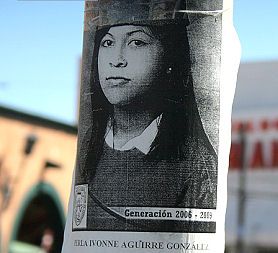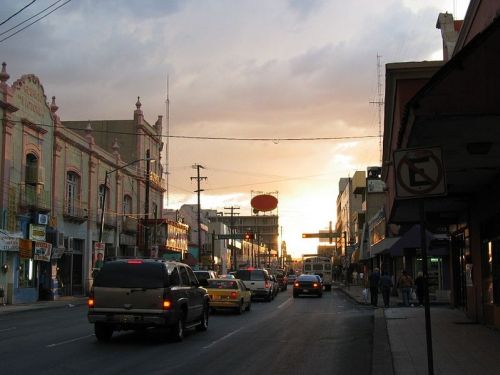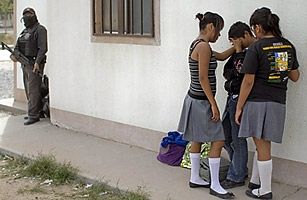
Publisher:
Bonnie King
CONTACT:
Newsroom@Salem-news.com
Advertising:
Adsales@Salem-news.com

~Truth~
~Justice~
~Peace~
TJP
May-17-2011 02:09

 TweetFollow @OregonNews
TweetFollow @OregonNews
Generations of the Disappeared
Salem-News.comVictims disappearing without a trace...
 Courtesy: ourlatinamerica.blogspot.com |
(CIUDAD-JUAREZ, Mexico) - When young women and girls began vanishing in Ciudad Juarez about two decades ago, Esmeralda Castillo was not even born. But in 2009, the 14-year-old middle school student joined the ranks of the disappeared.
“She was a normal girl, just like the rest,” Jose Luis Castillo, Esmeralda’s father, said in an interview.
The life-long resident of Ciudad Juarez said family members suspect Esmeralda disappeared while transferring buses on a Tuesday afternoon in the same downtown zone which is regularly plastered with posters of the latest missing women and where dozens of others have seemingly dropped off the face of the earth over the years.
Like other anguished parents before him, Castillo has no answers as to Esmeralda’s whereabouts. Castillo said he made routine treks to the morgue and probed the state prosecutor’s office responsible for investigating the disappearance. But after nearly two years, he can report no advances in locating Esmeralda.
In previous years, many relatives of the disappeared complained that state police investigators gave them the run-around, concocted wild stories, expressed indifference or argued that a lack of resources and personnel limited searches. Castillo, however, has a different account of his disillusionment with state law enforcement.
 Where is Lupita Perez Montes? |
“I come to the prosecutor’s office and they tell me, ‘Look for her yourself. We are afraid'.”
According to Castillo, the police told him they would need three patrols and a half-dozen officers to interview a possible witness or source of information.
Engulfed in a so-called drug war, Ciudad Juarez can be dangerous turf for cops. Police officers are frequent targets of ambushes and drive-by shootings.
“I don’t want to lose hope for a solution,” said Francisca Galvan, adviser to a new group of relatives formed to find their loved ones, “I still have hope that as organizations, as civil society we can find a solution, but there is no solution on the part of the authorities.”
Galvan said her group estimates 170 young women and girls are missing in Ciudad Juarez. Some cases are never publicized, she said, adding that group members sometimes run across distraught mothers wandering the downtown area in search of their daughters.
Unlike some earlier cases, Galvan said the latest ones involve potential victims disappearing without a trace.
“It would be a failure for the people of Mexico if no solution is found to this situation which has existed since 1993” Galvan insisted. Relatives’ frustrations prompted small groups of them to stage demonstrations in front of the state prosecutors’ office in Ciudad Juarez this month.
 Maria was 16-years-old when she was lured into the gang by |
Family members of the old disappeared joined with relatives of the new disappeared, whose numbers soared after conflict between organized crime groups escalated into all-out war in January 2008.
The spike in disappearances of young females also coincided with the deployment of thousands of Mexican soldiers and federal police as part of Operation Chihuahua, the government campaign officially proclaimed to curb violence and bring order to the streets of Ciudad Juarez.
“I am not crazy. I am a mother, who is very hurt by the disappearance of my daughter,” said Dona Eva Arce, who has searched relentlessly for her daughter Silvia since 1998.
In a lengthy Internet radio interview, Arce recounted how she had been threatened for investigating Silvia’s disappearance, and how she had spoken to two former high-ranking federal officials-ex-special prosecutor Maria Lopez Urbina and Guadalupe Morfin, the one-time head of the now-defunct Commission for the Prevention and Eradication of Violence against Women in Ciudad Juarez, about the numerous leads that pointed to underworld and police involvement in the disappearances of Silvia and her friend Griselda Mares.
According to Arce, the only response she got from Lopez and Morfin was advice to be cautious since the Ciudad Juarez mother was surfing dangerous waters.
 Ciudad-Juarez, Mexico approaching sunset. |
Elizabeth Flores, director of Pastoral Obrera, the Roman Catholic Church’s social action arm in Ciudad Juarez, told Frontera NorteSur that the Inter-American Court of Human Rights has specifically ordered the Mexican government to adopt measures that would facilitate swift and efficient investigations of disappearances of young women and girls.
Since the late 1980s, many of the disappeared were later found murdered, with numerous unsolved slayings having the characteristics of sex-related serial killings.
While efforts were made under the administration of former State Attorney General Patricia Gonzalez to design emergency and investigative response plans for disappearances, the protocols have not been put it into practice, Flores contended.
In a 2009 sentence the Mexican government is obligated to follow, the Inter-American Court praised efforts by federal, state and local officials to implement focused policing and search protocols in both 2003 and 2005, but stressed that operational activities needed to become much more rigorous.
The Inter-American Court’s order was part of the sentence handed down in connection to the murders of three young women in Ciudad Juarez back in 2001.
 Young people deal with the grief of the discovery of murder. |
In rendering its judgment, the Inter-American Court also ordered the government to create a web page that includes a mechanism for members of the public to communicate with authorities- even in an “anonymous” fashion- about disappeared women.
“The information contained in the web page should be permanently updated,” the Inter-American Court declared. The international justices noted their concern that such a web page previously maintained by the old Morfin commission had not been updated since December 2006.
More than three years later, the federal web page dedicated to missing women (mujeresdesaparecidascdjuarez.
Still, the Chihuahua state government does have a web page it declares is “in compliance with Resolution 20 of the sentence.”

For Ciudad Juarez, the page lists 108 females missing from 1995 (several years after disappearances began mounting) to April 11, 2011. However, only 28 of the missing have photos to accompany their names. Notably, the page mentions that 85 of the disappeared have gone missing since 2008.
The website also lists 107 females missing from other parts of Chihuahua state between 1993 to April 2011. But again, few names are accompanied by photos or other information that might alert members of the public who could have pertinent information.
The Chihuahua web page lists phone numbers the public can call but does not have a special e-mail address where information can be sent.
Hundreds of men also have reportedly been the victims of forced disappearance in Ciudad Juarez since the early 1990s, but except for the occasional street poster little public information is ever aired about the cases.
Relatives vow to press for answers about their missing daughters and loved ones. In an exasperated voice, Castillo described how his young daughter’s disappearance had devastated her mother and her family.
He blamed the overall circumstances surrounding Esmeralda’s disappearance on the violence and drug trafficking that’s ripped apart his city.
“It’s sad to be in Ciudad Juarez and see a little part of it die day-by-day,” Castillo lamented.
The father urged a mass protest in which all the residents hang up their telephones for one hour as a way of sending the authorities a message that “Juarez is united.”
Additional sources:
- Cimanoticias.com, May 11, 2011.
- El Diario de Juarez, May 10, 2011.
- Lapolaka.com, May 9, 2011. Griterio.org
Frontera NorteSur: on-line, U.S.-Mexico border news
Center for Latin American and Border Studies
New Mexico State University
Las Cruces, New Mexico
Articles for May 16, 2011 | Articles for May 17, 2011 | Articles for May 18, 2011





Quick Links
DINING
Willamette UniversityGoudy Commons Cafe
Dine on the Queen
Willamette Queen Sternwheeler
MUST SEE SALEM
Oregon Capitol ToursCapitol History Gateway
Willamette River Ride
Willamette Queen Sternwheeler
Historic Home Tours:
Deepwood Museum
The Bush House
Gaiety Hollow Garden
AUCTIONS - APPRAISALS
Auction Masters & AppraisalsCONSTRUCTION SERVICES
Roofing and ContractingSheridan, Ore.
ONLINE SHOPPING
Special Occasion DressesAdvertise with Salem-News
Contact:AdSales@Salem-News.com
Terms of Service | Privacy Policy
All comments and messages are approved by people and self promotional links or unacceptable comments are denied.
Johnette June 2, 2011 2:19 am (Pacific time)
Thats more than ssneilbe! Thats a great post!
[Return to Top]©2025 Salem-News.com. All opinions expressed in this article are those of the author and do not necessarily reflect those of Salem-News.com.